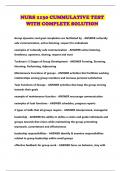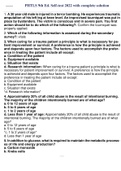Chapter 18 Managing Risk and Recovery
What is risk management?
Risk management is about identifying things that could go wrong, stopping them from going wrong,
reducing the consequences when things do go wrong, and recovering after things have gone wrong.
Accepting that failure occurs is not the same thing as tolerating or ignoring it. Although operations
managers do generally attempt to minimize both the likelihood of failure and the effect it will have,
the methods of coping with failure will depend on how serious its consequences are, and how likely
it is to occur. Some failures, although much less likely, are so serious in terms of negative
consequences that we class them as disasters.
Managing risk and recovery is relevant to all organizations and generally involves four sets of
activities:
1. Understanding what failures could potentially occur in the operation and assessing their
seriousness.
2. Examining ways to prevent failures from occurring.
3. To minimize the negative consequences of failure (failure or risk mitigation).
4. To devise plans and procedures that will help the operation to recover from failures when
they do occur.
How can operations assess the potential
causes and consequences of failure?
The first stage of risk management is to understand the
potential sources of risk. This means assessing where failure might occur and what the consequence
of failures might be. Often it is a failure to understand failure that results in unacceptable risk. The
classic approach to assessing potential failures is to inspect and audit operations activities. But
whatever approach to risk is taken, it can only be effective if the organizational culture that it is set
in fully supports a ‘risk-aware’ attitude.
Identify the potential causes of failure
The vast majority of failures are caused by something that could have been avoided. A simple
checklist of failure causes is useful. Failure sources are classified as:
1
, - Failures of supply
- Internal failures such as those deriving from human organizational and technological sources
- Cyber-security failures that can ‘open up’ an operation to external threats
- Failures deriving from the design of products and services
- Failures deriving from customer failures
- General environmental (or institutional) failures
Supply failure
Supply failure is any failure in the timing or quality of goods and services delivered into an operation.
It can be an important source of failure because of increasing dependence on outsourced activities
in most industries. It is also an important source of failure because of the emphasis on keeping
supply chains ‘lean’ in order to cut costs. Potentially the risk of disruption has increased dramatically
as the result of a too-narrow focus on supply chain efficiency at the expense of effectiveness.
Human failures
There are two broad types of human failure:
1. Where key personnel leave, become ill, die, or in some way cannot fulfil their role.
2. Where people are doing their job but are making mistakes.
Human failure through mistakes also comes in two types: errors and violations.
Errors: mistakes in judgement, where a person should have done something different.
Violations: acts that are clearly contrary to defined operating procedure.
Catastrophic failures are often caused by a combination of errors and violations.
Organizational failure
Organizational failure is usually taken to mean failures of procedures and processes and failures that
derive from a business’s organizational structure and culture. This is a huge potential source of
failure and includes almost all operations and process management.
Technology/facilities failures
By ‘technology and facilities’ we mean all the IT systems, machines, equipment and buildings of an
operation. All are liable to failure or breakdown. The failure may be only partial. Alternatively, it can
be what we normally regard as a ‘breakdown’ – a total and sudden cessation of operation. The route
cause of these failures can often be traced back to inadequate maintenance of exceptionally
2
What is risk management?
Risk management is about identifying things that could go wrong, stopping them from going wrong,
reducing the consequences when things do go wrong, and recovering after things have gone wrong.
Accepting that failure occurs is not the same thing as tolerating or ignoring it. Although operations
managers do generally attempt to minimize both the likelihood of failure and the effect it will have,
the methods of coping with failure will depend on how serious its consequences are, and how likely
it is to occur. Some failures, although much less likely, are so serious in terms of negative
consequences that we class them as disasters.
Managing risk and recovery is relevant to all organizations and generally involves four sets of
activities:
1. Understanding what failures could potentially occur in the operation and assessing their
seriousness.
2. Examining ways to prevent failures from occurring.
3. To minimize the negative consequences of failure (failure or risk mitigation).
4. To devise plans and procedures that will help the operation to recover from failures when
they do occur.
How can operations assess the potential
causes and consequences of failure?
The first stage of risk management is to understand the
potential sources of risk. This means assessing where failure might occur and what the consequence
of failures might be. Often it is a failure to understand failure that results in unacceptable risk. The
classic approach to assessing potential failures is to inspect and audit operations activities. But
whatever approach to risk is taken, it can only be effective if the organizational culture that it is set
in fully supports a ‘risk-aware’ attitude.
Identify the potential causes of failure
The vast majority of failures are caused by something that could have been avoided. A simple
checklist of failure causes is useful. Failure sources are classified as:
1
, - Failures of supply
- Internal failures such as those deriving from human organizational and technological sources
- Cyber-security failures that can ‘open up’ an operation to external threats
- Failures deriving from the design of products and services
- Failures deriving from customer failures
- General environmental (or institutional) failures
Supply failure
Supply failure is any failure in the timing or quality of goods and services delivered into an operation.
It can be an important source of failure because of increasing dependence on outsourced activities
in most industries. It is also an important source of failure because of the emphasis on keeping
supply chains ‘lean’ in order to cut costs. Potentially the risk of disruption has increased dramatically
as the result of a too-narrow focus on supply chain efficiency at the expense of effectiveness.
Human failures
There are two broad types of human failure:
1. Where key personnel leave, become ill, die, or in some way cannot fulfil their role.
2. Where people are doing their job but are making mistakes.
Human failure through mistakes also comes in two types: errors and violations.
Errors: mistakes in judgement, where a person should have done something different.
Violations: acts that are clearly contrary to defined operating procedure.
Catastrophic failures are often caused by a combination of errors and violations.
Organizational failure
Organizational failure is usually taken to mean failures of procedures and processes and failures that
derive from a business’s organizational structure and culture. This is a huge potential source of
failure and includes almost all operations and process management.
Technology/facilities failures
By ‘technology and facilities’ we mean all the IT systems, machines, equipment and buildings of an
operation. All are liable to failure or breakdown. The failure may be only partial. Alternatively, it can
be what we normally regard as a ‘breakdown’ – a total and sudden cessation of operation. The route
cause of these failures can often be traced back to inadequate maintenance of exceptionally
2








